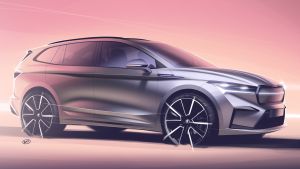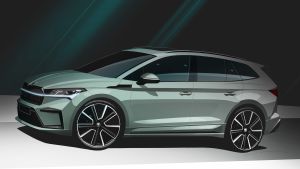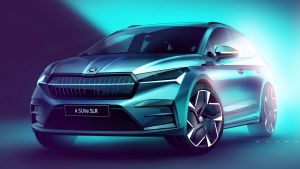Oliver Stefani is enthusing over the rear three-quarter angle of the new Enyaq. Should you find yourself in a showroom with the new EV, that’s the sweet spot you should look for, according to the trained eye of Skoda’s chief designer. He’s telling us all about what he hopes potential buyers of Skoda’s electric SUV will see when the car arrives in dealers this summer.
Stefani has spent the vast majority of his career within the Volkswagen automotive giant, working at the group between 1992 and 1999, then rejoining in 2002. He’s also an important man when it comes to all things MEB, the platform that underpins the new model. The German-born designer was responsible for the very first Volkswagen ID concept, now the ID.3 production car. He was also behind two more early MEB concept vehicles in the form of the ID. Crozz SUV and the ID. Buzz minibus as well.
- SEE MORE New Skoda Enyaq iV 2021 review
Perhaps no other designer in the VW Group fold has more experience with the MEB platform, then. And moving from VW to Skoda in 2017, Stefani’s biggest task has been to transfer that wealth of knowledge to the Czech brand’s first purpose-built all-electric vehicle (the company sold the Citigo-E iV, but that was based on a combustion-engined city car).
“Every brand has a job to do,” Stefani explains, when we start by asking him what he wanted to bring to the table with the design of the Enyaq in comparison with its Volkswagen ID.4 and Audi Q4 e-tron stablemates.
Although Skoda’s image has become smarter, sportier and sexier over the past decade, good old-fashioned practicality is still a big selling point for the brand. That’s a point of differentiation that Stefani is keen to get across in the design, shown here in a series of previously unreleased sketches from within the company’s studios.
“At Skoda, our rear overhang is longer than on the other cars, to offer more space and practicality,” he says. “Our loading edge [the boot lip in non-industry speak] is much lower. Our rear screen is also a bit more upright, to make more space. The whole Enyaq body size is specific to Skoda, and there is not a single body part we share with the other brands. This was a good synergy project for the group; for the customers we can offer really different kinds of cars for different tasks.”
At 4,649mm long, the newcomer is actually shorter than Skoda’s two family estates, the Superb and Octavia. And in SUV terms, its footprint sits beneath that of the Kodiaq at the top end of the line-up. The Enyaq is a lot lower than that model, too, but to the eye it’s still more of a ‘two-box’ SUV than its VW and Audi counterparts. The larger and more upright rear end that Stefani refers to delivers boot space of 585 litres with the back seats still in place, so the Skoda nails its brief of being the most practical of the VW Group’s mid-size electric SUVs.
These proportions are combined with some new design elements freshly inked into Stefani’s catalogue, to create an SUV that’s clearly still a Skoda, but one that’s also clearly separated from its combustion-engined stablemates as something entirely new. “You have to take care of the proportions and the brand identity, and put the product identity into the car,” explains Stefani. “Of course, there are some things that are new, and we offer different solutions on the MEB platform.”
This is where he is sure to nail down a key differentiating factor in the design process; even greater prioritisation of aerodynamic efficiency – a key reason why the Enyaq looks the way it does.
“From the aerodynamic work, there are some aesthetics we have used,” he says. “It is nice to show that the Skoda has a good drag coefficient – is aerodynamic – because it makes the car look more modern. People expect this good drag coefficient because they know it is related to the range [a key attribute of EV ownership that is less important in petrol and diesel cars]. The windscreen is much further forward.
We have a nice wingline and roofline, because the aerodynamics are even more important. We were always trying to achieve the best numbers we could. On the MEB cars it is more important, because whatever we gain brings extra range for our customers.”
This focus – labelled “going the extra mile” by Stefani, perhaps in literal terms – is all the more remarkable because Skoda doesn’t possess its own wind tunnel. What it does have, he points out, is expertise. “We have a team that is super skilled at calculating the airstream,” he reveals. “We work intensively with these guys. It has become some kind of hobby for our designers. But it does take more time.”
The extra ‘loops’ of calculations from the team – using processor-intensive Computational Fluid Dynamics (CFD) – have meant that some of the Enyaq’s most important design features are also some of the more subtle ones. “We had a solution on the roof and the spoiler,” Stefani recalls, “but then we experimented again and found that having a roof depression, and pushing the spoiler lower, brought better figures. Again, it’s the extra mile – but it meant good results.”
Skoda boss Thomas Schäfer has gone on the record to say the company wants more EVs by mid-decade. Stefani says the lessons learned during the Enyaq’s design process will transfer over into these projects. “At the moment we have just the Enyaq, so for further development of electric Skodas we can take a lot of these aerodynamic things and transfer them, and even improve them,” he teases.
“Then, of course, there’s the whole front design,” he adds – stopping short of confirming new cars himself, but suggesting that the Enyaq’s face could lend itself to an entire family of electric Skodas. “This is something that has to be worked out, but I would say this is the future.”
Of course, it’s not just the exterior design that’s a fresh direction for the brand; the interior is also new, and it’s something that Stefani hopes potential buyers of the car will pick up on during a showroom visit.
He paints the picture: “You go to the front door, sit inside and see this attractive, cool roominess. Then you feel the materials and experience this whole cosy, living-room feeling. Travelling electric is totally different to combustion. Sometimes it feels as if you’re flying. This noiseless travelling should also be reflected in the cabin.”
The cabin is another important differentiating factor for MEB cars. Although there’s a set of fixed points for many of the design elements, common across all vehicles using the platform, the Enyaq’s interior is a little more conventional-looking than you’ll find on some other EVs. For instance, the instrument panel is still recessed into the dashboard, and the car retains a row of physical buttons for key functions and ventilation. There’s an immediate familiarity, even though the brand has worked with an entirely new dashboard architecture: “It’s not a dash for a sports car, compact and driver-oriented. It’s calm – freedom,” says Stefani.
This leads Skoda’s design boss to explain another new paradigm he and his team foresee with electric models such as the Enyaq; cars will no longer be created by his team with exterior and interior as the only considerations. User interface and experience will become much more important elements, especially in the context of Skoda’s trademark Simply Clever features.
Classic items from conventional models, such as the umbrella in the driver’s door and an ice scraper tucked away in the tailgate, have been transferred over to the Enyaq, but Stefani says that the approach needs to move beyond physical features.
“We want to make something that is simple and easy to use for our customers,” he explains. “This has the same value as practicality or functionality. I think this is one of the big challenges of the future; we need to think about Simply Clever solutions also for the digital world.”
from Sitewide RSS feed https://ift.tt/2S5jM2k




No comments:
Post a Comment